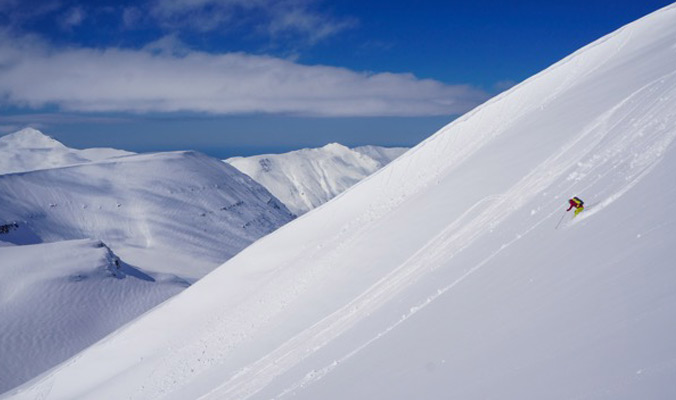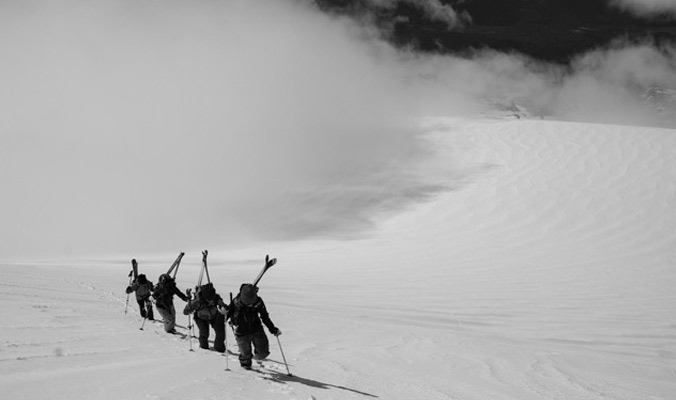
A skier on a day out with AMGA Guide Donny Roth picks a line down a sluffing slope, ready to adjust her course if needed. [Photo] Donny Roth
Here is how I try to approach group management in a more dynamic way.
Spacing
Spacing is the tactic people think they are most comfortable with, which leads to the answer, “One at a time.” The variable students forget to consider is the size of the hazard. A question I consider is, if an avalanche were to occur, how big would it be? Ideally, only one person is exposed at a time, and if I am faced with a wide slope and a big apron, I may need to clear the entire apron before the next person starts down.
If it is roly-poly terrain, I may suggest skiing closer together, if it is clear the avalanches don’t have a long run-out. But in spacing people out farther, I always remind students that good communication is major factor in safe travel, and it is easier to communicate when everyone is closer together.

On a big, planer slope that Roth and his clients have lapped a few times, it was time to let go. [Photo] Donny Roth
Relative Speed
Sometimes I ski conservatively, other times it’s open season. Sometimes speed is a friend, other times it’s my worst enemy. I recommend to students that if they don’t understand the snowpack, they need to ski conservatively so as to make adjustments on the fly. I suggest being ready for a convexity they couldn’t see from above, or a rock that may create a shallow spot they would like to avoid. We all love going fast, but students need to learn to have confidence in the run and the snowpack before committing to charging a run.
That said, going fast and straight can help a skier stay on “top” of the snow, and there is a time and place for this technique. When I come to a terrain feature—maybe a short rollover or a constriction between two rock outcroppings—I suspect the snow may be shallower and I may choose to “straighten out” my line for a bit. If I think 99 percent of the slope is stable, there’s no reason to test the spot I am unsure about by making a sweeping turn though it.
Straightlining shouldn’t be used to as a tool for skiing an entire slope a skier is uncertain of, but it can be useful in some circumstances. However, if the question is, “Do you think it will slide?” then, “I don’t know, just ski fast,” is not the answer.
The “Feel” of the Snow
Digging pits is a commonly understood way to decipher what is going on in the snowpack before jumping into a run, but sometimes conditions can also change while skiing. For this reason, I try to pay attention to the way the snow feels as I make my way down a line. I ask myself, “How deep is it? How dense is it? Will the surface move?” Often, asking these questions simply directs me to a better skiing experience in general, but sometimes, especially with wind slabs and storm slabs, this can also be a safety issue. If the snow has just stiffened up, maybe I’ve skied into a slab. If the snow got shallower, maybe I’m closer to a weak layer.
Other questions I may have are, “Is the snow now moving with me? Is it heavy slough, or worse?” I think about what I expect the snow to feel like, and if it doesn’t meet my expectations, I consider investigating matters further.

Donny Roth brings clients into avalanche terrain, but with great stability, they can travel as a tight group. This improves their ability to communicate and help move faster. [Photo] Donny Roth
Where to Go If Something Changes
I always have a plan for where I may need to escape. Once I’m moving, decisions need to be made more quickly. It is easier to choose between a couple of predetermined options than it is to create a new one. Before I start skiing, I like to be able to make a statement like, “If the snow gets stiffer, I will move higher on the ridge.” This way, I don’t need to develop a plan on the fly.
Refining this skill will take time and practicing this skill helps with an understanding of how snow can change as it falls and moves over terrain.
Bottom Line: Don’t downplay the importance of this final stage of the decision-making process. There’s more to backcountry skiing than choosing between one-at-a-time and all at once.
—
Donny Roth is an AMGA-certified ski guide and professional skier. He writes about his adventures at independent-descents.com. Learn more about skiing with him in Chile at chile-powder-adventures.com.










Related posts:
Mountain Skills: Bruce Tremper on 20 years of education, safety and snow science
Tools of the Trade: When, where and how to use your ice axe, crampons and rope
Mountain Skills: Should I Stay or Should I Blow?
The Snow Pro: Avalanche forecaster Drew Hardesty sets his intentions for success